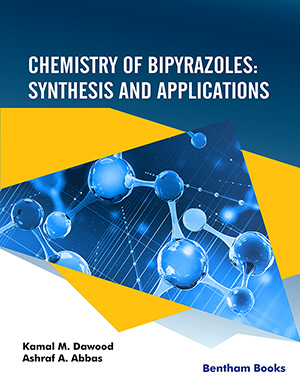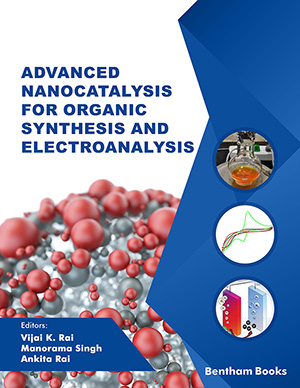
Abstract
Keeping in view the ever growing demand and application of the organic small molecules based sensitive and selective fluorescence detection strategies for the trace metallic ions in the ecosystem, fluids and inside intracellular media, the present literature survey was focused on the recent development on the organic skeleton based fluorescence sensor for the zinc ion as Zn2+ is the second most abundant transition metal after iron in human body. The prominent organic based skeletons introduced during the past three years for zinc detection including azine, ((Z)-N´-(quinolin-2-ylmethylene)furan-2- carbohydrazide), nicotinohydrazide, hydrazone, phenolic cage, 4-methyl-2,6-bis[(E)-(2- (4-phenylthiazol-2-yl)hydrazono)methyl]phenol, bipyridine, N-(quinoline-8-yl)pyridine-2- carboxamide, anthracene, Schiff base, salen, helicene, Carbon Quantum Dots (CDs) functionalized with Calix[4]arene, coumarin, diaminomaleonitrile, peptide, hydroxypyrazole, salicylhydrazide were discussed in detail with particular focus on ligand-zinc complexation mechanism, UV-visible and fluorescence investigation, spectral variation, isosbestic emergence, limit of detection, ligand-zinc binding stoichiometry, association/binding constant and applications for intracellular tracing of metallic contamination via confocal fluorescence microscopic studies. Among the several discussed optical probes, rhodamine and fluorescein based material offer appreciable sensitivity, exhibiting drawback of pH sensitivity. Probes based on these ligands triggered “turn-on” signal even in the absence of metals upon fluctuation in pH e.g., acidic in former case and basic in the latter case. Hydroxypyrazole-based ligands also showed detection signal variation by switching the pH of the solution. Schiff base and bipyridyl scaffold were found to possess good ligation toward the several transition metals. Azole, oxazole, thiazole, thiadiazole, hydrazine carboxamide and hydrazine carbothiomide are the bioactive molecules exhibiting good cell viability and probes designed by using these central nucleus might be better to invest for intracellular imaging. Symmetrical heterocyclic cage like probe showed better chelation toward several transition metals and it is a good choice for the design and development of sensor for simultaneous detection of several transition metals.
Keywords: Zinc sensor, organic skeletons, fluorescence, bioimaging, optical parameters, pH sensitivity, symmetrical heterocycles, hydrazine derivatives.
[http://dx.doi.org/10.1016/j.jphotochem.2016.11.003]
[http://dx.doi.org/10.1016/j.jphotochem.2015.10.027]
[http://dx.doi.org/10.1016/j.jphotochem.2017.02.011]
[http://dx.doi.org/10.1016/j.saa.2015.07.062] [PMID: 26196932]
[http://dx.doi.org/10.1016/j.saa.2015.07.090] [PMID: 26232576]
[http://dx.doi.org/10.1007/s10895-015-1723-x] [PMID: 26585349]
[http://dx.doi.org/10.1016/j.saa.2016.09.014] [PMID: 27665189]
[http://dx.doi.org/10.1016/j.jlumin.2015.02.004]
[http://dx.doi.org/10.1016/j.saa.2016.12.002] [PMID: 28024244]
[http://dx.doi.org/10.1016/j.micromeso.2016.04.005]
[http://dx.doi.org/10.1016/j.jece.2017.01.017]
[http://dx.doi.org/10.1016/j.saa.2013.09.104] [PMID: 24161519]
[http://dx.doi.org/10.1016/j.saa.2014.10.060] [PMID: 25459728]
[http://dx.doi.org/10.1007/s10895-011-0955-7] [PMID: 21870075]
[http://dx.doi.org/10.1039/C4RA07552H]
[http://dx.doi.org/10.1021/jo301193n] [PMID: 22924706]
[http://dx.doi.org/10.1016/j.snb.2011.10.036]
[http://dx.doi.org/10.1016/j.molcatb.2014.03.021]
[http://dx.doi.org/10.1021/bm400762h] [PMID: 23822160]
[http://dx.doi.org/10.1021/ic034760x] [PMID: 14606827]
[http://dx.doi.org/10.1016/j.jlumin.2010.11.030]
[http://dx.doi.org/10.1016/j.jlumin.2011.01.024]
[http://dx.doi.org/10.1016/j.dyepig.2009.11.003]
[http://dx.doi.org/10.3390/ijms11010329] [PMID: 20162019]
[http://dx.doi.org/10.7598/cst2012.158]
[http://dx.doi.org/10.1186/1752-153X-6-161] [PMID: 23256784]
[http://dx.doi.org/10.1042/BSR20150154] [PMID: 26839417]
[http://dx.doi.org/10.1039/C4TB01239A]
[http://dx.doi.org/10.1016/j.apsusc.2014.04.122]
[http://dx.doi.org/10.1021/cr100383r] [PMID: 21395328]
[http://dx.doi.org/10.1021/cr068000q] [PMID: 18652512]
[http://dx.doi.org/10.1021/cr100154p] [PMID: 20726526]
[http://dx.doi.org/10.1039/c3cs35429f] [PMID: 23400370]
[http://dx.doi.org/10.1039/c2cs35152h] [PMID: 22885471]
[http://dx.doi.org/10.1039/c0cs00224k] [PMID: 21445455]
[http://dx.doi.org/10.1039/b802497a] [PMID: 18648672]
[http://dx.doi.org/10.1039/C1CS15245A] [PMID: 22184584]
[http://dx.doi.org/10.1021/cr2004103] [PMID: 22702347]
[http://dx.doi.org/10.1016/j.ccr.2011.09.010]
[http://dx.doi.org/10.1016/j.saa.2011.07.032] [PMID: 21855400]
[http://dx.doi.org/10.1016/j.poly.2014.08.024]
[http://dx.doi.org/10.1016/j.bmc.2007.04.016] [PMID: 17467997]
[http://dx.doi.org/10.1016/j.microc.2015.12.028]
[http://dx.doi.org/10.1016/j.jnoncrysol.2016.07.037]
[http://dx.doi.org/10.1016/j.aca.2016.03.045] [PMID: 27126792]
[http://dx.doi.org/10.1016/j.cplett.2017.02.003]
[http://dx.doi.org/10.1016/j.dyepig.2016.09.041]
[http://dx.doi.org/10.1016/j.jcis.2016.07.026] [PMID: 27450889]
[http://dx.doi.org/10.1016/j.saa.2013.12.090] [PMID: 24468984]
[http://dx.doi.org/10.1039/c0ob00983k] [PMID: 21311797]
[http://dx.doi.org/10.1016/j.snb.2011.08.037]
[http://dx.doi.org/10.1016/j.saa.2013.09.118] [PMID: 24161851]
[http://dx.doi.org/10.1016/j.jlumin.2012.02.035]
[http://dx.doi.org/10.1016/j.snb.2005.08.014]
[http://dx.doi.org/10.1016/j.jlumin.2015.09.009]
[http://dx.doi.org/10.1016/j.jlumin.2016.07.031]
[http://dx.doi.org/10.1016/j.jlumin.2016.11.057]
[http://dx.doi.org/10.1016/j.molstruc.2016.05.074]
[http://dx.doi.org/10.1016/j.bmcl.2013.04.042] [PMID: 23668987]
[http://dx.doi.org/10.1016/j.molstruc.2016.10.027]
[http://dx.doi.org/10.1016/j.tet.2016.03.052]
[http://dx.doi.org/10.1016/j.tet.2016.07.077]
[http://dx.doi.org/10.1016/j.tet.2016.08.023]
[http://dx.doi.org/10.1016/j.tetlet.2016.03.074]
[http://dx.doi.org/10.1016/j.bmcl.2013.10.015] [PMID: 24200807]
[http://dx.doi.org/10.1016/j.jlumin.2014.12.035]
[http://dx.doi.org/10.1016/j.tetlet.2016.04.106]
[http://dx.doi.org/10.1016/j.jphotochemrev.2017.01.003]
[http://dx.doi.org/10.1016/j.dyepig.2013.07.030]
[http://dx.doi.org/10.1016/j.dyepig.2016.04.003]
[http://dx.doi.org/10.1016/j.dyepig.2016.08.063]
[http://dx.doi.org/10.1016/j.dyepig.2016.11.010]
[http://dx.doi.org/10.1016/j.inoche.2014.10.007]
[http://dx.doi.org/10.1016/j.snb.2011.12.021]
[http://dx.doi.org/10.1007/s10895-017-2178-z] [PMID: 29064051]
[http://dx.doi.org/10.1007/s10895-016-1933-x] [PMID: 27646651]
[http://dx.doi.org/10.1039/C5RA11388A]
[http://dx.doi.org/10.1016/j.dyepig.2017.02.033]
[http://dx.doi.org/10.1016/j.jinorgbio.2011.02.012] [PMID: 21497578]
[http://dx.doi.org/10.1016/j.clay.2016.12.034]]
[http://dx.doi.org/10.1016/j.apsusc.2016.08.104]
[http://dx.doi.org/10.1016/j.snb.2013.12.023]
[http://dx.doi.org/10.1007/s10895-015-1505-5] [PMID: 25595058]
[http://dx.doi.org/10.1016/j.saa.2018.09.019] [PMID: 30227347]
[http://dx.doi.org/10.1016/j.jiec.2018.04.040]
[http://dx.doi.org/10.1016/j.snb.2018.05.022]
[http://dx.doi.org/10.1016/j.snb.2018.08.026]]
[http://dx.doi.org/10.1021/acs.cgd.7b01752]
[http://dx.doi.org/10.1016/j.saa.2017.08.017] [PMID: 28818764]
[http://dx.doi.org/10.1039/C8NJ00158H]
[http://dx.doi.org/10.1016/j.snb.2018.07.012]
[http://dx.doi.org/10.1039/C8NJ01580E]
[http://dx.doi.org/10.1016/j.snb.2018.06.019]
[http://dx.doi.org/10.1016/j.saa.2018.06.008] [PMID: 29902756]
[http://dx.doi.org/10.1016/j.snb.2018.05.049]]
[http://dx.doi.org/10.1039/C7NJ04216G]
[http://dx.doi.org/10.1021/acssensors.8b00158] [PMID: 29733581]
[http://dx.doi.org/10.1016/j.aca.2017.12.048] [PMID: 29422126]
[http://dx.doi.org/10.1016/j.snb.2017.12.200]
[http://dx.doi.org/10.1016/j.snb.2018.01.106]
[http://dx.doi.org/10.1016/j.snb.2017.08.038]
[http://dx.doi.org/10.1016/j.jlumin.2017.11.018]
[http://dx.doi.org/10.1039/C7RA13592K]
 58
58 1
1


























